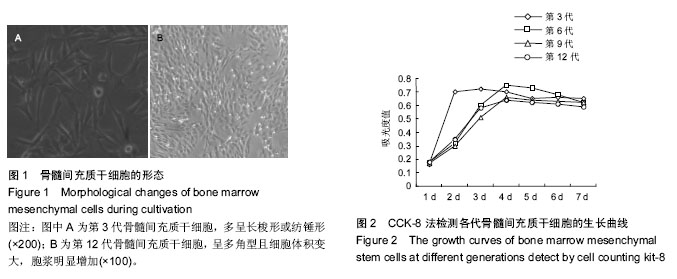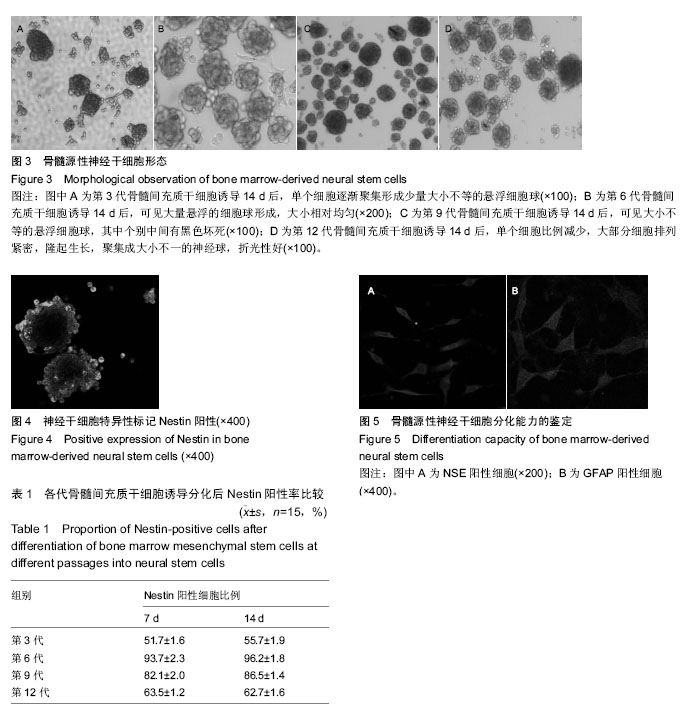| [1] Tocci A, Forte L.Mesenchymal stem cell: use and perspectives.Hematol J. 2003;4(2):92-96.
[2] Carvalho MM, Teixeira FG, Reis RL, et al. Mesenchymal stem cells in the umbilical cord: phenotypic characterization, secretome and applications in central nervous system regenerative medicine. Curr Stem Cell Res Ther. 2011;6(3):221-228.
[3] Zou DF,Chen Y,Han YX,et al.Overexpression of microRNA-124 promotes the neuronal differentiation of bone marrow-derived mesenchymal stem cells. Neural Regen Res. 2014;9(12): 1241-1248.
[4] Kalbasi Anaraki P, Patecki M, Larmann J, et al. Urokinase receptor mediates osteogenic differentiation of mesenchymal stem cells and vascular calcification via the complement C5a receptor. Stem Cells Dev. 2014;23(4):352-362.
[5] Tan SL, Ahmad TS, Selvaratnam L, et al. Isolation, characterization and the multi-lineage differentiation potential of rabbit bone marrow-derived mesenchymal stem cells. J Anat. 2013;222(4):437-450.
[6] Verdi J, Mortazavi-Tabatabaei SA,Sharif S,et al.Citalopram increases the differentiation efficacy of bone marrow mesenchymal stem cells into neuronal-like cells. Neural Regen Res. 2014;9(8): 845-850.
[7] 杨照耀,董启榕.骨髓间充质干细胞的体外表达与表面特性标志的实验研究[J].美中国际创伤杂志,2005,4(1):1-3.
[8] 陈静娟,李华,许志恩,等.无血清神经培养基体外培养大鼠骨髓源性神经干细胞[J].中国组织工程研究与临床康复, 2010,14(19): 3441-3445.
[9] 柯俊龙,许志恩,李华,等.细胞密度与骨髓间充质干细胞向神经元样细胞的分化[J].中国组织工程研究与临床康复, 2010, 14(32): 5908-5912.
[10] Dominici M, Le Blanc K, Mueller I, et al. Minimal criteria for defining multipotent mesenchymal stromal cells. The International Society for Cellular Therapy position statement. Cytotherapy. 2006;8(4):315-317.
[11] Ahmed S.The culture of neural stem cells.J Cell Biochem. 2009;106(1):1-6.
[12] Ramasamy S, Narayanan G, Sankaran S, et al. Neural stem cell survival factors. Arch Biochem Biophys. 2013; 534(1-2):71-87.
[13] Zhang GY,Wang J,Jia YJ,et al.MicroRNA-9 promotes the neuronal differentiation of rat bone marrow mesenchymal stem cells by activating autophagy. Neural Regen Res. 2015;10(2): 314-320.
[14] Ma K, Fox L, Shi G, et al. Generation of neural stem cell-like cells from bone marrow-derived human mesenchymal stem cells. Neurol Res. 2011;33(10): 1083-1093.
[15] Bruder SP, Jaiswal N, Haynesworth SE. Growth kinetics, self-renewal, and the osteogenic potential of purified human mesenchymal stem cells during extensive subcultivation and following cryopreservation. J Cell Biochem. 1997;64(2):278-294.
[16] Johnstone B, Hering TM, Caplan AI, et al. In vitro chondrogenesis of bone marrow-derived mesenchymal progenitor cells. Exp Cell Res. 1998; 238(1):265-272.
[17] Digirolamo CM, Stokes D, Colter D, et al. Propagation and senescence of human marrow stromal cells in culture: a simple colony-forming assay identifies samples with the greatest potential to propagate and differentiate. Br J Haematol. 1999;107(2):275-281.
[18] Banfi A, Muraglia A, Dozin B, et al. Proliferation kinetics and differentiation potential of ex vivo expanded human bone marrow stromal cells: Implications for their use in cell therapy. Exp Hematol. 2000;28(6):707-715.
[19] Sekiya I, Colter DC, Prockop DJ. BMP-6 enhances chondrogenesis in a subpopulation of human marrow stromal cells. Biochem Biophys Res Commun. 2001; 284(2):411-418.
[20] Hao H, Chen G, Liu J, et al. Culturing on Wharton's jelly extract delays mesenchymal stem cell senescence through p53 and p16INK4a/pRb pathways. PLoS One. 2013;8(3):e58314.
[21] Joseph M, Das M, Kanji S, et al. Retention of stemness and vasculogenic potential of human umbilical cord blood stem cells after repeated expansions on PES-nanofiber matrices. Biomaterials. 2014;35(30): 8566-8575.
[22] Molchadsky A, Shats I, Goldfinger N, et al. p53 plays a role in mesenchymal differentiation programs, in a cell fate dependent manner. PLoS One. 2008;3(11):e3707.
[23] Mohanty ST, Cairney CJ, Chantry AD, et al. A small molecule modulator of prion protein increases human mesenchymal stem cell lifespan, ex vivo expansion, and engraftment to bone marrow in NOD/SCID mice. Stem Cells. 2012;30(6):1134-1143.
[24] Olivares-Navarrete R, Hyzy SL, Park JH, et al. Mediation of osteogenic differentiation of human mesenchymal stem cells on titanium surfaces by a Wnt-integrin feedback loop. Biomaterials. 2011;32(27): 6399-6411.
[25] Zhang DY, Wang HJ, Tan YZ. Wnt/β-catenin signaling induces the aging of mesenchymal stem cells through the DNA damage response and the p53/p21 pathway. PLoS One. 2011;6(6):e21397.
[26] 阎文柱,秦书俭,刘学政,等.体外培养大鼠骨髓间充质干细胞向神经元样细胞分化:Wnt3a信号分子的诱导作用[J]. 中国组织工程研究与临床康复, 2010, 14(14): 2476-2480.
[27] Bolzoni M, Donofrio G, Storti P, et al. Myeloma cells inhibit non-canonical wnt co-receptor ror2 expression in human bone marrow osteoprogenitor cells: effect of wnt5a/ror2 pathway activation on the osteogenic differentiation impairment induced by myeloma cells. Leukemia. 2013;27(2):451-463.
[28] 施剑明,邬亚华,耿书国,等.间充质干细胞增殖、衰老及分化:Wnt信号通路经典与非经典的调控作用[J].中国组织工程研究, 2014,18(41):6719-6724. |
.jpg)


.jpg)